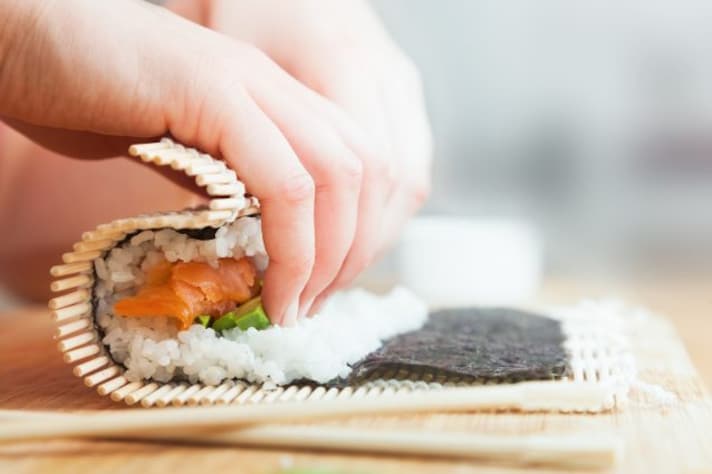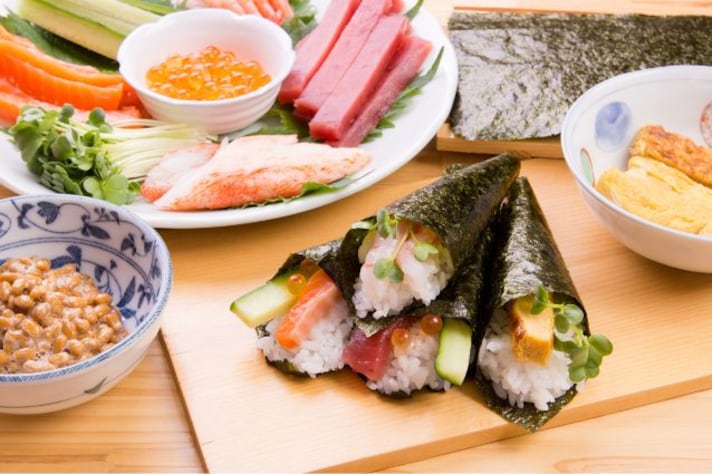What Are the Differences Between a Sushi Roll and a Hand Roll?
When dining at a sushi restaurant, you'll probably see maki (rolls) and temaki (hand rolls), similar in their names, but with different preparations. Maki, cylindrical and sliced into bite-sized pieces, is ideal for formal dining. Temaki, on the other hand, is cone-shaped and eaten by hand and suited for casual settings.

Sushi, a staple of Japanese cuisine, has become one of the most renowned dishes globally, gracing menus from Tokyo to New York and everywhere in between. Its rise in popularity has led to a proliferation of sushi spots and restaurants, making it easy to indulge in this culinary delight almost anywhere. Yet, as you scan the menu, the variety of sushi names can be bewildering. "Maki" and "temaki" might sound similar, but are they interchangeable? Not quite! Each type of sushi has unique characteristics that set them apart. Let's dive into the delicious world of sushi and explore the differences between maki and temaki – or rolls and hand rolls.
What is Maki?
Sushi rolls, "maki" in Japan, is perhaps the most iconic image that comes to mind when thinking about sushi. Maki sushi is typically made by spreading a layer of vinegared rice over a sheet of nori (seaweed), then adding fillings like fresh fish, vegetables, and sometimes even tropical fruits. This combination is rolled into a cylindrical shape using a bamboo mat called a makisu. The result is a beautifully compact roll that is sliced into bite-sized pieces, perfect for dipping in soy sauce or adding a touch of wasabi.
Historically, maki sushi has roots that trace back to the Edo period in Japan, where it was developed as a convenient, portable food. Its uniform size and neat presentation make it an ideal option for both formal dining and casual snacking.

What is Temaki?
On the other hand, temaki, or hand rolls, offers a more laid-back approach to sushi. Temaki is crafted by taking a sheet of nori and filling it with vinegared rice and various fillings, just like maki. However, instead of rolling it into a cylinder, the nori is rolled into a conical shape, resembling an ice cream cone. This sushi is designed to be eaten with your hands, hence the name "hand roll."
The history of temaki is less formal and more rooted in the idea of sushi as a quick, accessible food. It’s a great option for those who want a substantial bite without the formality of chopsticks. The larger size and unstructured nature of temaki make it a fun and interactive way to enjoy sushi, perfect for casual dining or sushi parties where making your own hand rolls can be part of the fun.
What Are The Differences Between Maki and Temaki
The most obvious difference is their shape and size. Maki rolls are small, uniform, and neatly sliced into pieces, making them ideal for sharing and presenting on a plate. Temaki, on the other hand, is much larger and cone-shaped, meant to be enjoyed individually and immediately after being made to prevent the nori from becoming soggy.

Another difference lies in the eating experience. Maki is typically eaten with chopsticks, allowing for a more refined and controlled bite. In contrast, temaki is a hands-on experience, often resulting in a more rustic and personal connection with the food. It’s sushi’s answer to the debate between knife-and-fork versus finger food.
When to Order Maki or Temaki
Choosing between maki and temaki depends on the dining context and personal preference. Maki is perfect for a more formal dining experience or when sharing with friends and family. Its bite-sized pieces make it easy to sample a variety of flavors without committing to a single large roll. Plus, it looks impressive on a sushi platter, adding to the overall dining experience.
Temaki, however, shines in more relaxed settings. It’s ideal for a quick lunch, a sushi picnic, or a fun, interactive dining experience. If you’re at a sushi party or a casual gathering, hand rolls can be a delightful and customizable option, allowing everyone to create their own sushi masterpieces.
;Resize,width=767;)

;Resize,width=712;)
;Resize,width=712;)
